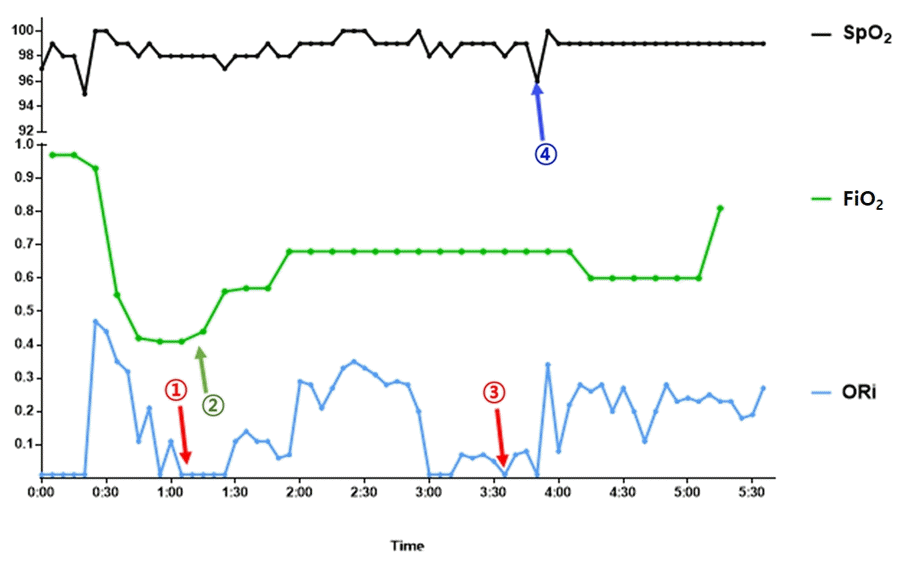CASE REPORT
Case 1
 | Fig. 1.Intraoperative ORi, SpO2, and FiO2 of HFNC in Case 1. ORi: oxygen reserve index, SpO2: pulse oximetry saturation, FiO2: fraction of inspired oxygen, HFNC: high flow nasal cannula. This figure reveals the change of ORi and SpO2 over time and FiO2 we adjusted in Case 1. We maintained ORi above 0.2 by adjusting the FiO2 and flow rate of HFNC. The time and arrow in parentheses is the same as the time and arrow in Table 1. ① ORi suddenly decreased to zero (time from 1:10 to 1:30). ② ORi recovered by increasing FiO2 to 0.56. ③ During the speech test (time from 3:00 to 3:50), the ORi suddenly dropped to zero. ④ SpO2 reacted later than ORi, it decreased to 95%. |
Table 1.
BIS: bispectral index, Ce: effect site concentration, FiO2: fraction of inspired oxygen, HFNC: high flow nasal cannula, TCI: target-controlled infusion, ORi: oxygen reserve index, PaO2: partial pressure of oxygen, SpO2: oximetry saturation, PaCO2: partial pressure of alveolar carbon dioxide. When we recorded BIS, it was the lowest value for that time period. The time and arrow in parentheses is the same as the time and arrow in Fig. 1. We started TCI of sedative agents (time 0:50), with applying HFNC as 15 L/min and FiO2 as 0.4. When pinned to the head, after increasing the dose of remifentanil, ORi suddenly decreased to zero (time from 1:10 to 1:30, marked by ① in the Fig. 1). It recovered by increasing FiO2 to 0.56 (marked by ② in the Fig. 1). When the surgery started (time 1:50), ORi again fell close to zero and we raised FiO2 to 0.68 after which ORi recovered. During the speech test (time from 3:00 to 3:50), the ORi repeatedly dropped to zero (marked by ③ in the Fig. 1), each time confirming that the nasal cannula was removed from the patient. When the nasal cannula applied to the patient again, ORi recovered above 0.2. SpO2 reacted later than ORi (marked by ④ in the Fig. 1). After the neurologic exam, PaO2 in arterial blood gas analysis was 223 mmHg, we adjusted FiO2 as 0.6 and flow rate as 30 L/min with HFNC until the end of the surgery.




 PDF
PDF Citation
Citation Print
Print



 XML Download
XML Download